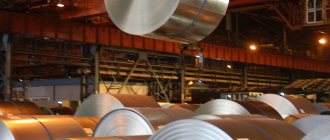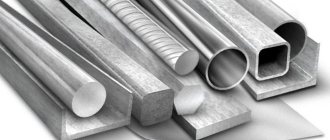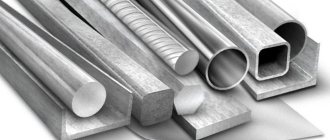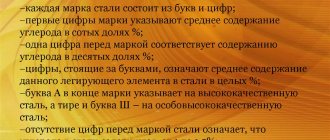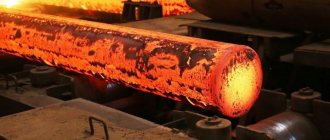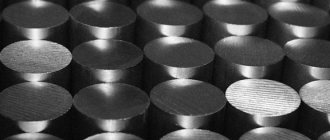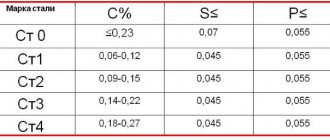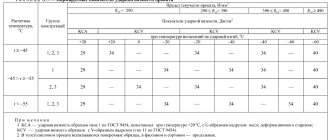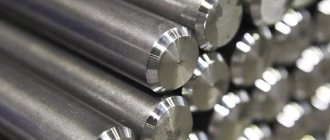01/19/2022 Author: VT-METALL
From this material you will learn
:
- Differences between alloy steel and carbon steel
- Alloying additives for steel
- Types of Alloy Steel
- Marking of alloy steels
- Applications of alloy steel
An alloy containing less than 45% iron is called steel. In addition to iron, the usual one includes carbon and various impurities. Alloy steel contains additional elements, so-called alloying elements. They are necessary to give the material different properties.
Depending on these additives, alloy steel acquires characteristics that contribute to its wider use. Due to alloying elements, it becomes resistant to the external environment, ductility and strength increase, and qualities that are required to solve certain problems appear. Our article will help you understand the types and grades of alloy steel, as well as its purpose.
Carbon steels: features, classification, processing and application
Carbon steel is a metallurgical composition with a low content of additives and a high iron content - up to 99 ½%. This material is in high demand in various industries, which explains its high share in production - up to 80%. Today, about 2 thousand brands have been developed. The structure of a material depends on its carbon content. By changing the percentage you can influence characteristics such as hardness, fluidity, ductility and density. The carbon content of the material is critical at 0.8%.
Regarding this indicator, the US is distinguished:
- if C is less than 0.8%, ferrite and pearlite are present in the structure of the material;
- at a C (carbon) content of 0.8%, the material is characterized by a pearlite structure;
- when the C content is more than 0.8%, cementite appears in the structure.
The general trend with increasing C content is expressed in an increase in strength, impact strength and cold brittleness threshold, but the ductility of rolled products decreases.
Classification of carbon steels
In addition to classification by structural parameters, they are usually distinguished by production technology:
- electric control systems;
- open hearth;
- oxygen converter.
The material is divided according to the level of deoxidation:
In terms of quality, in accordance with the presence and volume of harmful impurities, the iron alloy is:
- normal quality;
- quality steel.
According to the scope of use of the control system there are:
- ordinary;
- instrumental;
- structural.
Based on the presence and volume of C in the carbon iron alloy, the material is classified:
- high-carbon steel grades with a C content of more than 0.65%;
- medium carbon - from 0.25 to 0.6%;
- low-carbon steel grades with a C content of up to 0.25%.
The higher the carbon indicators, the harder and stronger the material, but also the higher its fragility. The marking of a material is directly related to its purpose:
- Ordinary quality is designated by the conventional letter designation Art. This is followed by numbers from 1 to 7, which show the C (carbon) content, a multiple of 10. The production of iron alloys of this group is regulated by GOST 380-85. Additionally, these materials are usually distinguished by supply group: A, B and C. This designation is indicated before the brand (group A is not indicated). For A - the mechanical properties are stable, for B the mechanical composition is stable, for C the properties and composition are stable.
- Structural control systems are regulated by GOST 380-88, marking is carried out with numbers: from 08 to 85. These numbers inform about the C (carbon) content in the material in hundredths of a percent. If an iron alloy is characterized by an increased manganese content, G is indicated at the end of the marking.
- Instrumental control systems are regulated by GOST 1435-54 and 5952-51. This iron alloy is of high quality and is marked with the letter U. This is followed by numbers that show the volume of carbon in tenths of a percent. There is a subgroup of the highest quality, in this case the designation ends with the letter A. They are characterized by a high carbon content.
It is customary to indicate the degree of deoxidation in the brand designation: ps or ks.
The percentage of C in the composition of tool steel is determined by its use. U7 - for the production of forging hammers, dies and chisels, U8 is used for the production of tools for working with stone and metal, U9 is optimal for the production of stamps and punches. Subsequent modifications are used to produce blades of hacksaws, drills, dies, and cutters.
Types of Alloy Steel
There are three main categories of such steels, the classification of which takes into account the proportion of impurities and alloying additives.
- Low alloy steel
– its composition contains approximately 2.5% alloying elements. - Medium alloy steel
- includes 2.5–10% alloying substances. - High-alloy steel
- contains more than 10% of the additives we are interested in, and their content can reach up to 50%.
The properties of the metal depend on the proportion of carbon. If its amount is 0.25–2.14%, the steel is carbon and is classified as follows:
- high carbon: 0.6–2%;
- medium carbon: 0.3–0.6%;
- low carbon: no more than 0.25%.
Adding new components is impossible without removing some of the old ones, otherwise linking is impossible. Purification allows you to reduce the share of harmful impurities and oxygen. Carbon is removed by burning due to the precipitation of carbides and other methods. Additives can be added to any steel, but this procedure does not always give the desired result.
In alloy steel, the carbon component is indicated in hundredths of a percent. There is a classification of alloy steels based on the total mass of additives:
- low alloyed – up to 2.5%;
- medium alloyed – 2.5–10%;
- highly alloyed - from 10%.
Due to the content of additives in alloy steel, recrystallization and the formation of a new structure occur. Based on the shape of the crystal lattice, the following classes of steel are distinguished:
- Ferrites
. Magnetic, the lattice is unstable, changes as a result of heating, cooling, transforming into perlite, sorbitol, trostite. This group includes all low-alloy and carbon steels.
It is possible to ensure the formation of stable bonds by reducing the proportion of carbon to 0.15% and adding chromium as an alloying component.
- Austenites
. They are characterized by a high content of nickel, chromium and manganese. Due to their structural structure, they are heat-resistant, plastic, and are not afraid of rust. This group includes chromium-nickel stainless steels.
- Martensites
. Cooling after quenching leads to martensitic transformation, resulting in the formation of cubic cells that make up needle or lath crystals. The metal acquires memory, so it is able to partially recover after deformation.
Steels containing chromium, molybdenum, vanadium, tungsten, niobium and other components that provide heat resistance can go into this state.
The metal crystal lattice is organized in the form of phases - most often there are two phases at once. Let's say there can be austenite and ferrite. The required phase is increased using additives and exposure to temperature.
During smelting, cast iron is obtained from ore, which is refined, that is, purified from gases, oxides, and other inclusions. Oxygen is removed with coal, slag, manganese and other deoxidizers - they cause the formation of gases or heavy oxides that precipitate.
The process of decarburization, or carbon removal, from alloy steel uses hydrogen and burns out the carbides, which releases carbon monoxide and forms scale. At the moment, some enterprises use modern technologies, such as gas-oxygen refining.
The quality of the metal depends on the result of these procedures. Based on this feature, the following steels are distinguished:
- Ordinary, or ordinary
. This is the cheapest material with a carbon content of around 0.6%, while there are air bubbles in the metal. The most common brands are: STO, St3sp, St5kp. - High quality
. This includes calm, semi-calm and boiling species, which contain oxygen, nitrogen, and hydrogen. In this case, the maximum concentration of gases is achieved in boiling water. Steels can be carbon and alloyed grades St08kp, St10ps, St20, 7ХФ, 8ХФ. - High quality
. They are distinguished by a reduced content of sulfur and phosphorus - within 0.03%. These steels are smelted in electric furnaces without the use of coal. These include 6ХВ2С, 6Х3ФС. - Particularly high quality
. Hot metal undergoes deep cleaning to remove oxides, sulfides, and non-metallic inclusions. As a result, up to 0.01% sulfur and 0.025% phosphorus remain in it. We are talking, for example, about a brand such as 30ХГС3-Ш.
In addition, there is a classification of alloy steels based on their purpose
:
Structural
They are used for the production of building structures and loaded mechanisms.
Types of structural alloy steels:
- Improveable. They stand out against the general background due to their high chromium content, enriched with boron, nickel, molybdenum, manganese, and are used for heat treatment.
- Spring-spring. They contain added silicon, cobalt, manganese, boron, titanium, and are used in the production of transport.
- Bearing. They are characterized by increased hardness and wear resistance, always contain chromium and a minimum content of non-metallic additives.
- Heat resistant. Used in the production of steam heaters.
Tool (cutting and stamping)
Additives added to tool alloy steels are responsible for increased strength and uniformity. Most often, the metal undergoes heat treatment and is used for the manufacture of cutters, cutters, and taps. Alloying is carried out with chromium, vanadium, titanium and other components.
Such steels are very expensive and high-speed, which is why they are used exclusively in cutting planes. For measuring instruments, chromium, tungsten, and manganese are added to the metal, ensuring its hardness and dimensional stability.
Steels with special properties, namely stainless, heat-resistant, wear-resistant, etc.
We are talking about a significant group, the metals in which have different properties:
- High-strength – high-alloy steels with a selected composition, thanks to which the metal is used for the production of critical components of mechanisms.
- Stainless steel - includes manganese, chromium, suitable for working in chemically aggressive environments, used for the production of pipes.
- Wear-resistant - characterized by a high proportion of manganese. They are used to make railroad switches, tracks, mining equipment, and excavator buckets.
In addition to the mentioned steels, this group includes heat-resistant, heat-resistant, magnetic, non-magnetic, rheostatic, and with high electrical resistance.
Modern alloys are complex alloyed compounds with unique characteristics. Thus, 15Kh2NMFA steel is designed to ensure the radiation life of a reactor installation for 100 years, and 17KhNGT is used as a material for special-purpose springs.
The difference between carbon steels and alloy steels
US grades distinguish between technological processes and the use of various additives. So what is the difference between carbon steels and alloy steels if elements are also added to these iron alloys that change the mechanical, operational and technological parameters:
- Carbon iron alloys contain iron, carbon and normal impurities, which can be beneficial or harmful. The first include manganese and silicon. Harmful impurities are sulfur and phosphorus.
- The material does not contain alloying additives that change properties, such as molybdenum, titanium, tungsten and others.
- CS are not intended for special use; it is a general industrial material.
- Compared to alloyed materials, carbon alloys have lower technological and operational parameters, including hardness and heat resistance.
Scope of application of carbon steels
The scope of application of the control system is determined by the type. Thus, low-carbon steel is used for cold deformation and hot forging; its grades are characterized by high ductility. Iron alloys with an average carbon content differ slightly in terms of fluidity and ductility, but its strength is already higher. They are relevant for the production of structural elements and mechanisms that will be used under normal conditions. CWs with a high carbon content have high strength; various tools and measuring instruments are made from them. Standard quality control is used in the production of sheet material, channels, rods, beams and other products. Machine elements and metal structures are made from it.
Features of welding medium-carbon steels
High C content is the cause of welding problems, such as:
- probability of formation of crystallization cracks;
- the appearance of brittle structures and cracking;
- the difficulty of obtaining the same strength of the weld and the base metal.
The following measures will help you eliminate potential problems and get a quality connection:
- Reducing the amount of C in the weld metal . To solve this problem, low-carbon electrode rods and wire are used.
- Providing preliminary and accompanying heating of the seam . Heating is usually carried out to +250…+300°C. This is one of the measures to prevent the formation of brittle hardened structures. The higher the C content, the higher the heating temperature should be.
- Modification of the metal of the weld area . The proportion of base metal can be reduced and the proportion of electrode metal in the weld can be increased by using welding wire of small cross-section and low welding current. Welding with direct current of straight polarity shows good results.
- Welding steel elements of significant thickness in a slide or cascade and slowing down the cooling of the seam . Such measures make it possible to eliminate the conditions for the formation of brittle hardening structures.
- Welding of heat-strengthened grades is carried out with long beads along previously laid and already cooled beads . This technology ensures equal strength of the weld metal and the heat-affected zone.
Submerged arc welding is not common for medium-carbon steels, since in this case it loses its main advantage - high productivity. To equalize the characteristics of strength and ductility of the weld and the base metal, heat treatment is used, usually quenching + tempering.
Carbon steel processing
The main types of carbon processing are: annealing, hardening, normalization, aging and tempering.
- Carbon steels of ordinary quality. Group A alloy is supplied for products that are not processed. Group B - these are materials that are intended for stamping, forging, and sometimes heat treatment. Group B is alloys that can be processed by welding.
- High quality carbon steel. This material can be subjected to thermal processing, normalization, cold machining, upset, stamping and pressure processing. Features of the technological process depend on the specific brand.
One of the main advantages of this iron alloy is its low cost. It is this factor that determines the wide applicability of the material.
Low carbon steel and its main characteristics
Low-carbon steel is an alloy that does not contain alloying elements, has impurities and a low carbon content, up to 0.25%. This alloy contains manganese and silicon, but due to its low percentage (manganese - no more than 1%, silicon - no more than 0.8%), they do not have a noticeable alloying effect on the material. Low-carbon steel is soft and has a low manganese content.
Due to its softness, this alloy does not allow precise surface processing, but its softness, toughness and ductility make it possible to create cemented workpieces and parts for subsequent welding/cementation. The machinability of the alloy is very poor, the surface of the workpiece has many roughnesses. Carrying out precise processing is quite difficult.
Case-hardened, temperable and high-strength steels
Case-hardened steels are low-carbon (up to 0.25 C), low- (up to 2.5%) and medium-alloyed (2.5...10% total content of alloying elements) steels. They are intended for machine parts and devices operating in friction conditions and experiencing shock and variable loads.
Steel grade 15ХА with a tensile strength σ in MPa is intended for the manufacture of small parts operating under friction conditions at medium pressures and speeds. For the manufacture of critical parts operating at high speeds, high pressures and shock loads, steel grades 18ХГ and 25ХГМ . For large, critical, heavily loaded parts, steels 20ХН and 20Х2Н4А .
In the manufacture of large, especially critical, heavily loaded parts operating at high speeds with the presence of vibration and dynamic loads, steel with a tensile strength in MPa grade 18Х2Н4МА .
The performance of such parts depends on the properties of the core and surface layer of the metal. Case-hardening steels are saturated with carbon from the surface (cemented) and subjected to heat treatment (hardening and tempering). This treatment provides high surface hardness (HRC 58...63) and maintains the required toughness and specified strength of the metal core.
Improved alloy steels are medium-carbon (0.25...0.6% C) and low-alloy steels. To ensure the necessary properties (strength, ductility, toughness), these steels are thermally improved by hardening and high tempering (at 500...600°C).
Improved and case-hardening steels after heat treatment give strength up to σ in MPa and toughness up to KS= 0.8...1.0 MJ/m2. Such strength is not enough to create new modern machines. Steels with a strength limit of σ in MPa are required. For these purposes, complex alloyed and maraging steels are used. The properties of such steels and their purpose are shown in table. 2.
Table 2. Improved alloy steels
| Brand | Limit strength at stretching _ σв, MPa | Relative elongation δ,% | Specific viscosity KS, MJ/m2 | Purpose |
| 40ХС | 1250 | 12 | 0,35 | Some parts operating under conditions of increased stress and alternating loads |
| 40HFA | 900 | 10 | 0,9 | |
| 30HGFA | 1100 | 10 | 0,5 | Parts operating under friction conditions and critical welded structures operating under alternating loads and temperatures up to 200°C |
| 40ХН2МА | 1100 | 12 | 0,8 | Large, critical, heavily loaded parts with complex shapes |
Complex alloy steels are medium-carbon (0.25...0.6% C) alloy steels that are heat-strengthened during low tempering or subjected to thermomechanical treatment.
Maraging steels are a new class of high-strength alloy steels based on carbon-free (no more than 0.03% C) alloys of iron with nickel, cobalt, molybdenum, titanium, chromium and other elements. Maraging steels are hardened in air from 800...860°C, followed by aging at 450...500°C.
Properties of Low Carbon Steel
The properties of low carbon steel do not have high strength values. Plasticity and viscosity, on the contrary, are high. Low-carbon steel grades are sometimes intended for the manufacture of case-hardened products that require additional case-hardening to achieve the required hardness and make them wear-resistant through further processing. Products made from such steel are quite well welded and forged.
The properties of low-alloy steel do not allow full-fledged work with this metal. However, if the process of normalization and cold drawing is carried out, the machinability of the surface can be significantly increased. Due to good ductility (5 = 33...23%), low-carbon steels can be successfully subjected to cold deformation, without losing mechanical properties, since local overstress is evenly distributed and cracks do not form. Such steel is weakly hardenable and welds well.
The properties of low-carbon steel have a number of disadvantages:
- low strength Te = 330...460 MPa, Sto.2 = 200...280 MPa;
- low impact strength;
- very sensitive to mechanical aging, since under repeated loads it senses stress concentrations, so products subject to repeated loads are not made from it.
Grades of low-carbon steel, their main areas of application
The grade of low-carbon steel, depending on its composition, has specific purposes in industry. This type of alloy includes 05 kp, 08, 10, 10 ps, which are actively used for the production of washers, gaskets and other light-loaded structural elements and machines. Depending on the grade of low-carbon steel , the alloy is used in different industries. Thus, high resistance to static hydrogen fatigue is demonstrated by:
The following grades of low-carbon steel are used as case-hardening steel:
In the manufacture of gears with subsequent cementation, the following is used:
- EP620;
- EP355;
- 03 are used as a charge billet and are produced in the form of rods of various sizes. This charge additive is used in the process of smelting special alloys for the manufacture of individual parts and special rolled products.
To create welded structures, the following grades of low-carbon steel :
- St0;
- St1sp;
- St1ps;
- St1kp;
- St2sp;
- St2ps;
- St2kl;
- St3sp;
- ST3kl (GOST 380);
- steel 10;
- steel 15;
- steel 20 (GOST 1050);
- S235-S295;
- P235-P295 (EN 10025, EN 10027-1, EN 10028-2).
Technologies used
Three improvement options have become prevalent:
- Hardening at elevated temperatures (in molten salt or hot oil), which helps to significantly reduce the deformation of parts. This process is used mainly for alloy steels and parts with sharp differences in cross-sections;
- Austenitization is an option implemented for products with thin profiles. Used for most grades of medium or high carbon steels, as well as for large parts made of alloy steels. Austenitization requires high-temperature quenching and holding, usually in molten salt, but it minimizes the risk of shape distortion, and the resulting structure does not require subsequent tempering;
- Hardening at normal temperatures in water or oil, but followed by two-stage tempering: first at higher and then at lower temperatures. It is used for spring steels in which the formation of tempering sorbitol is difficult.
For improved tool steels, instead of tempering, annealing is carried out, and the hardening temperature (compared to the recommended) is increased by 20...300C. This heat treatment is provided after rough metal-cutting operations.
What kind of steel is upgradeable? This question is often asked by thermal experts, given that the class of products improved by heat treatment is not clearly defined. According to modern views, two criteria are mainly taken into account - hardenability and cold brittleness.

